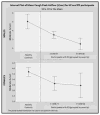Measurement of Voluntary Cough Production and Airway Protection in Parkinson Disease
- PMID: 26551228
- PMCID: PMC4769912
- DOI: 10.1016/j.apmr.2015.10.098
Measurement of Voluntary Cough Production and Airway Protection in Parkinson Disease
Abstract
Objective: To examine relations between peak expiratory (cough) airflow rate and swallowing symptom severity in participants with Parkinson disease (PD).
Design: Cross-sectional study.
Setting: Outpatient radiology clinic at an acute care hospital.
Participants: Men and women with PD (N=68).
Interventions: Participants were cued to cough into an analog peak flow meter then swallowed three 20-mL thin liquid barium boluses. Analyses were directed at detecting potential relations among disease severity, swallowing symptom severity, and peak expiratory (cough) airflow rate.
Main outcome measures: Peak expiratory (cough) airflow rate and swallow symptom severity.
Results: Peak expiratory (cough) airflow rate varied significantly across swallowing severity classifications. Participants with more severe disease displayed a significant, linear decrease in peak expiratory (cough) airflow rate than those participants with earlier stage, less severe disease. Swallowing symptom severity varied significantly across groups when comparing participants with less severe PD with those with more severe PD. Participants with early stage PD demonstrated little to no swallowing symptoms and had the highest measures of peak expiratory (cough) airflow rate. In contrast, participants with the most severe swallowing symptoms also displayed the lowest measures of peak expiratory (cough) airflow rate.
Conclusions: Relations existed among PD severity, swallowing symptom severity, and peak expiratory (cough) airflow rate in participants with PD. Peak expiratory (cough) airflow rate may eventually stand as a noninvasive predictor of aspiration risk in those with PD, particularly those with later stage disease. Inclusion of peak expiratory (cough) airflow rates into existing clinical swallowing assessments may increase the sensitivity and predictive validity of these assessments.
Keywords: Airway management; Cough; Parkinson disease; Rehabilitation; Respiratory aspiration.
Copyright © 2016 American Congress of Rehabilitation Medicine. Published by Elsevier Inc. All rights reserved.
Conflict of interest statement
Figures






Similar articles
-
Sequential voluntary cough and aspiration or aspiration risk in Parkinson's disease.Lung. 2014 Aug;192(4):601-8. doi: 10.1007/s00408-014-9584-7. Epub 2014 May 3. Lung. 2014. PMID: 24792231 Free PMC article.
-
Reflex Cough and Disease Duration as Predictors of Swallowing Dysfunction in Parkinson's Disease.Dysphagia. 2016 Dec;31(6):757-764. doi: 10.1007/s00455-016-9734-6. Epub 2016 Jul 26. Dysphagia. 2016. PMID: 27461481
-
Comparison of voluntary and reflex cough effectiveness in Parkinson's disease.Parkinsonism Relat Disord. 2014 Nov;20(11):1226-30. doi: 10.1016/j.parkreldis.2014.09.010. Epub 2014 Sep 16. Parkinsonism Relat Disord. 2014. PMID: 25246315 Free PMC article.
-
Using voluntary cough to detect penetration and aspiration during oropharyngeal swallowing in patients with Parkinson disease.Chest. 2010 Dec;138(6):1426-31. doi: 10.1378/chest.10-0342. Epub 2010 Aug 12. Chest. 2010. PMID: 20705802
-
Swallowing and esophageal function in Parkinson's disease.Am J Gastroenterol. 1995 Oct;90(10):1741-6. Am J Gastroenterol. 1995. PMID: 7572887 Review.
Cited by
-
Dysphagia in Parkinson's Disease Improves with Vocal Augmentation.Dysphagia. 2019 Dec;34(6):862-868. doi: 10.1007/s00455-019-09982-z. Epub 2019 Jan 29. Dysphagia. 2019. PMID: 30694413
-
Analysis of Dysphagia and Cough Strength in Patients with Unilateral Vocal Fold Paralysis.Dysphagia. 2023 Apr;38(2):510-516. doi: 10.1007/s00455-021-10274-8. Epub 2021 Mar 17. Dysphagia. 2023. PMID: 33728514
-
Characteristics of impaired voluntary cough function in individuals with amyotrophic lateral sclerosis.Amyotroph Lateral Scler Frontotemporal Degener. 2019 Feb;20(1-2):37-42. doi: 10.1080/21678421.2018.1510011. Epub 2019 Jan 17. Amyotroph Lateral Scler Frontotemporal Degener. 2019. PMID: 30652513 Free PMC article.
-
Dysphagia in Parkinson Disease: Part I - Pathophysiology and Diagnostic Practices.Curr Phys Med Rehabil Rep. 2023 Jun;11(2):176-187. doi: 10.1007/s40141-023-00392-9. Epub 2023 Mar 28. Curr Phys Med Rehabil Rep. 2023. PMID: 37608845 Free PMC article.
-
Respiratory-Swallow Coordination in Individuals with Parkinson's Disease: A Systematic Review and Meta-Analysis.J Parkinsons Dis. 2023;13(5):681-698. doi: 10.3233/JPD-230057. J Parkinsons Dis. 2023. PMID: 37393516 Free PMC article.
References
-
- Parkinson J. An Essay On The Shaking Palsy. Chicago: American medical Association Press; 1932.
Publication types
MeSH terms
Grants and funding
LinkOut - more resources
Full Text Sources
Other Literature Sources
Medical

